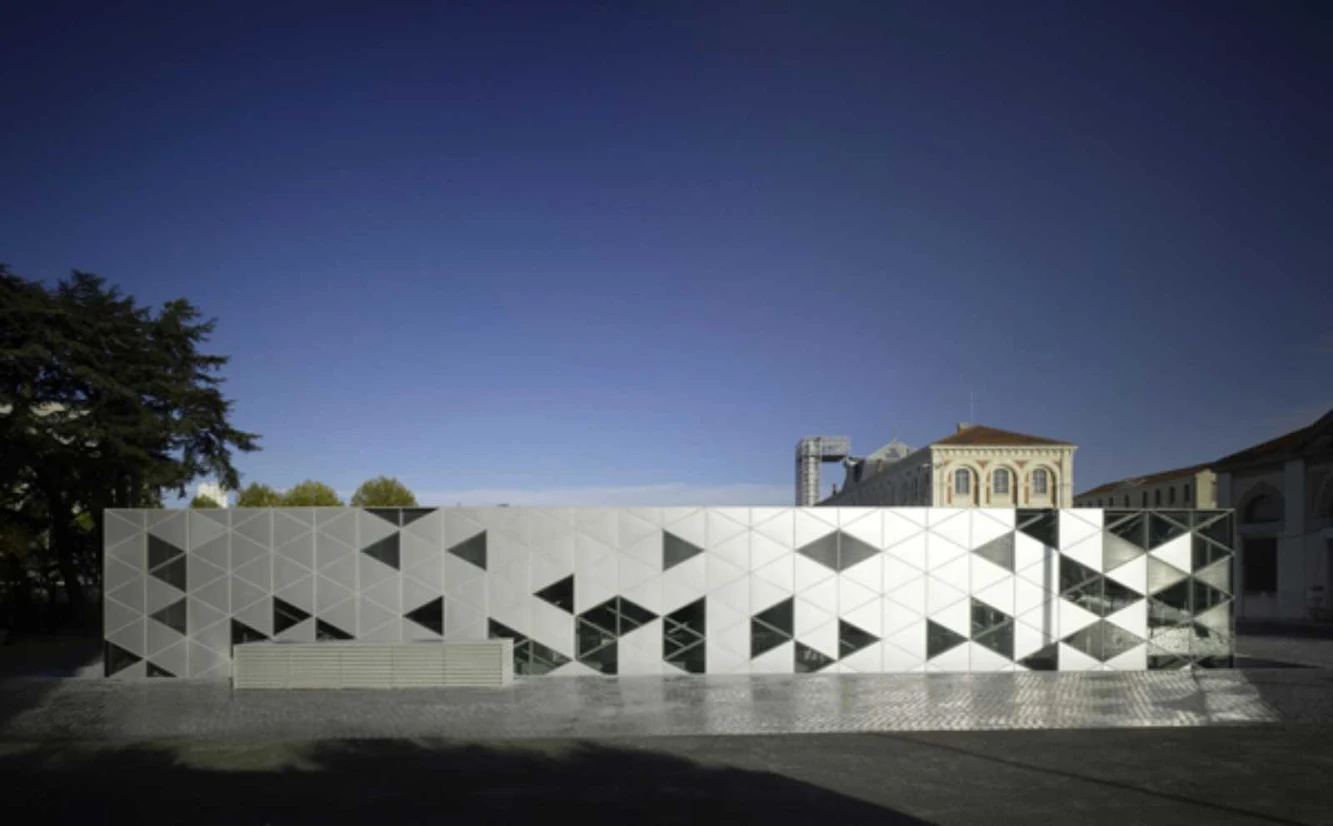
The Cité du Design in Saint-Étienne is a new and unique institution for research, education, communication and media, and design related services. It addresses diverse groups, combining urban and social activities with industrial and artistic expertise. A single slender body, the Platine, is integrated into the site of the Manufacture d’armes, a former arms factory.

While the site and its heritage are made of many isolated and hierarchical buildings, the program of Cité du Design asks for continuity. the Platine is a slender building (200 m x 32 m) designed as a place of merging and irrigation for the site, a connecting switchboard, articulating the different activities in the Cité du Design. Inside the platine, public and semi-public areas define the intensity of light, the spatial dimensions and the degree of climatic protection.

The Cité du Design is not a closed campus but an open place intended to receive the city’s experience and become a field for mutual research. the Agora is the most public area, containing a 24-hour café, linking the city permanently with Cité du Design. the platine also contains seminar rooms, two exhibitions areas, a mediatheque associated with the Design School, and a greenhouse related to the café and a food design program

Structure the homogeneity and distribution of forces in all directions generates a non-hierarchical structure – a monospace free of any intermediate support. Seen from inside, the minimal dimensions of the profiles transform the structure into a vibration marking the boundary between the interior and the exterior. This Monospace will act as a switchboard that links communication facilities to the many programmes housed in various buildings throughout the site. the observation tower is the pioneering element that signifies the starting point of this transformation.

Light the Platine skin is also capable of regulating lighting, reacting to outdoor conditions and inside needs. Panels can change angles so as to block sunlight, controlling lighting in exhibition spaces or areas with high light levels, such as the Greenhouse or the Agora.

Skin the Platine envelope, consisting of 14,000 equilateral triangles measuring 1.2 m per side is a graduated and reactive skin: modulation between opaque and clear, insulated or interclimatic, open or closed, reflects and accompanies the various cycles and interactions of the Cité du design. the choice of glazing type allows a distribution of natural light depending on the use of the premises. Thermal qualities of the panels permit the climatic quality of the envelope to be modulated according to unplanned criteria of the premises.

The possibility of integrating solar panels (photovoltaic and experimental) into the skin of the Platine allow solar energy production as well as development and testing of innovative solar energy materials. the skin reacts continuously to changes in climate. It may also be given new functions. in the longer term, the panels may be replaced or modified to be adapted to changing needs or to allow for areas of experimentation.

Interclimatic Laboratory the Platine is designed as a whole, where each part interacts with its environment, and where each element is both the result and the determinant of other factors. Its design closely regulates the climatic environments and aims for energy independence. the climatic design varies according to the area. This climate gradation allows interior conditions to be adapted to needs without having to treat the entire volume of the Platine. However, the zones themselves are interactive, for example, the pre-conditioned air from the Greenhouse is taken for the benefit of the winter aeration of the attached zones.

The two layers of the envelope are involved in climatic regulation. the outer layer of the various panels can modulate the inputs into the different areas according to their needs. It filters the light, absorbs and transforms it into energy, and also regulates air and heat exchanges. the low emissivity layer of interior walls enables the energy dissipated by the heating/cooling floor to be reflected, like a thermal mirror. Under the Platine a geothermal energy system is implemented, via thermal activation of foundation piles, use of Canadian well for pre-conditioning of fresh air and air exchanges between zones to reduce energy consumption.

Geothermal Canadian Walls Geothermal energy consists of two combined networks: the first, a field of twenty-four probes in a double U with a length of 100 ml each, provides available energy of 130 kW; the second, a field of piles (1st in France), composed of recovery loops in the one hundred foundation piles (tubes set in the reinforcing bar cages) of the Platine building, giving available energy of 80 kW. A Canadian well is used to treat the air. to make this technology as economical as possible, the crawl space under the Platine is enclosed and can therefore assure this function.






Location: Saint-Etienne, France Architect: Lin Architects Partners in Charge: Finn Geipel, Giulia Andi Project Team: David Letellier, Stefan Jeske, Philip König, Jacques Cadilhac, Susana Draeger, Judith Stichtenoth, Jan-Oliver Kunze Wiesje Bijl, Laura Delaney, Olaf Dolfus, Simon Wiesmaier Interns: Marielle Gilibert, Anna Heilgemeir, François Maisonnasse, Muriel Poncet, Emma Williams, Guillaume De Morsier, Alana Cooke Local Architect: Dominique Berger, Sandra Tauveron, Cabinet Berger Assistance construction management Maurice Guitton, Benjamin Wallerand, Werner Sobek, Thomas Winterstetter, Wsi Structure: Frederique Binvignat, Christian Desquiens, Betom Ingénierie, Corbas Engineering: Matthias Schuler, Arnaud Billard, Transsolar Climate: Economy: Pierre Dumond, Alain Baland, Cyprium Acoustics: Richard Denayrou, Emily Morin, Altia Acoustique Scenography: Gérard Fleury, Architecture & Technique Lightning: Andy Sedgwick, Jeff Shaw, Ove Arup Landscape Design: Clément Willemin, Frank Poirier, Base Information Design: Andreas Schneider, Iidj Art: Lucy + Jorge Orta Model: Werk5 Surface: 17,250 m2 (net), 64,000 m2 Cite Du Design Cost: 41, 54 Mio € Year: 2009 Client: Saint-Etienne Metropole Photo: Christian Richters, Francois Maisonnasse, Jan-Oliver Kunz